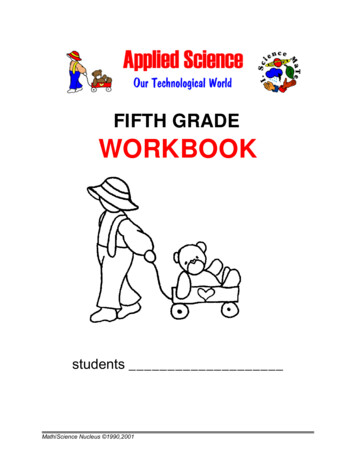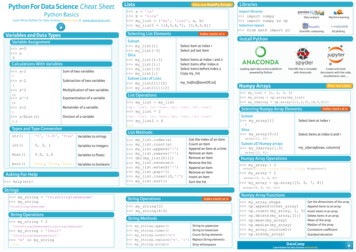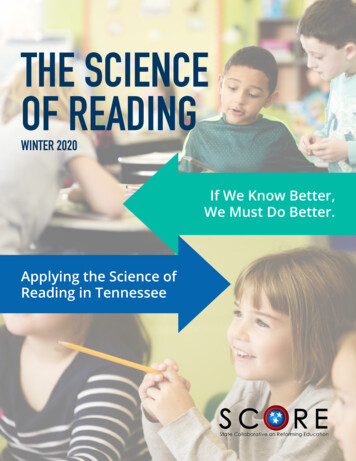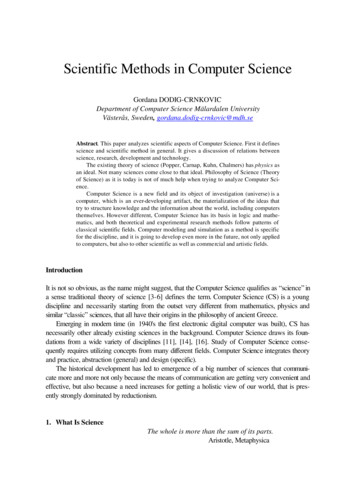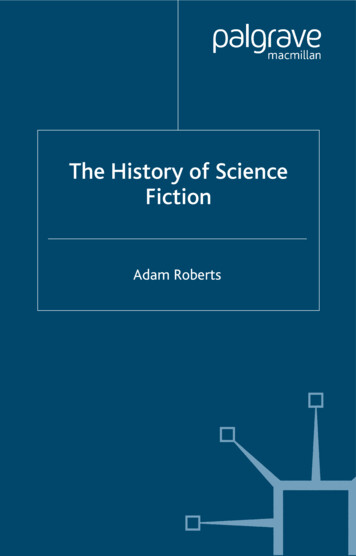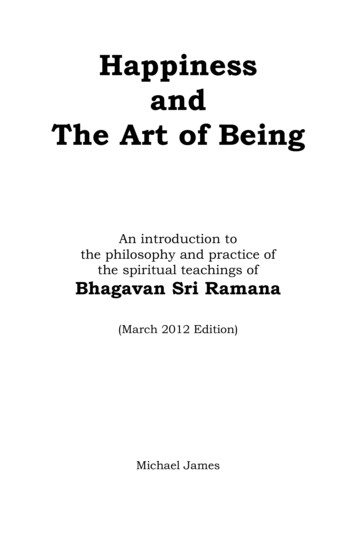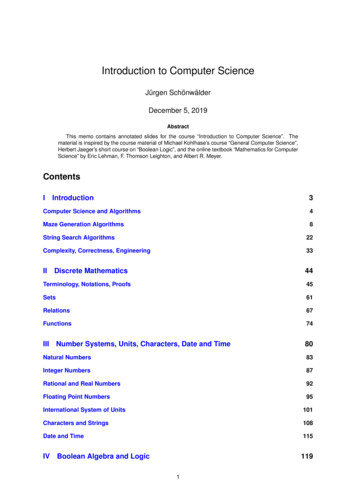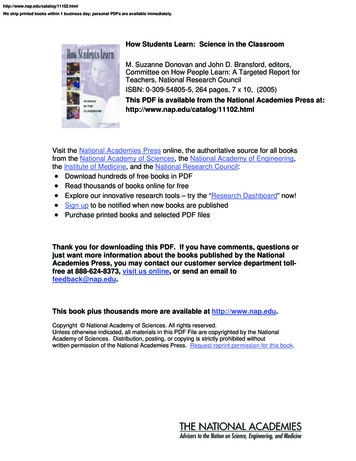
Transcription
http://www.nap.edu/catalog/11102.htmlWe ship printed books within 1 business day; personal PDFs are available immediately.How Students Learn: Science in the ClassroomM. Suzanne Donovan and John D. Bransford, editors,Committee on How People Learn: A Targeted Report forTeachers, National Research CouncilISBN: 0-309-54805-5, 264 pages, 7 x 10, (2005)This PDF is available from the National Academies Press at:http://www.nap.edu/catalog/11102.htmlVisit the National Academies Press online, the authoritative source for all booksfrom the National Academy of Sciences, the National Academy of Engineering,the Institute of Medicine, and the National Research Council: Download hundreds of free books in PDF Read thousands of books online for free Explore our innovative research tools – try the “Research Dashboard” now! Sign up to be notified when new books are published Purchase printed books and selected PDF filesThank you for downloading this PDF. If you have comments, questions orjust want more information about the books published by the NationalAcademies Press, you may contact our customer service department tollfree at 888-624-8373, visit us online, or send an email tofeedback@nap.edu.This book plus thousands more are available at http://www.nap.edu.Copyright National Academy of Sciences. All rights reserved.Unless otherwise indicated, all materials in this PDF File are copyrighted by the NationalAcademy of Sciences. Distribution, posting, or copying is strictly prohibited withoutwritten permission of the National Academies Press. Request reprint permission for this book.
How Students Learn: Science in the Classroomhttp://www.nap.edu/catalog/11102.htmlHow Students LearnSCIENCE IN THE CLASSROOMCommittee on How People Learn, A Targeted Report for TeachersM. Suzanne Donovan and John D. Bransford, EditorsDivision of Behavioral and Social Sciences and EducationCopyright National Academy of Sciences. All rights reserved.
How Students Learn: Science in the Classroomhttp://www.nap.edu/catalog/11102.htmlTHE NATIONAL ACADEMIES PRESS 500 Fifth Street, N.W. Washington, D.C. 20001NOTICE: The project that is the subject of this report was approved by the Governing Board of the National Research Council, whose members are drawn from thecouncils of the National Academy of Sciences, the National Academy of Engineering,and the Institute of Medicine. The members of the committee responsible for thereport were chosen for their special competences and with regard for appropriatebalance.This study was supported by Award No. R215U990024 between the National Academy of Sciences and the U.S. Department of Education. Any opinions, findings,conclusions, or recommendations expressed in this publication are those of theauthor(s) and do not necessarily reflect the views of the organizations or agenciesthat provided support for the project.Library of Congress Cataloging-in-Publication DataNational Research Council (U.S.). Committee on How People Learn, A TargetedReport for Teachers.How students learn : history, mathematics, and science in the classroom /Committee on How People Learn, A Targeted Report for Teachers ; M. SuzanneDonovan and John D. Bransford, editors.p. cm."Division of Behavioral and Social Sciences and Education."Includes bibliographical references and index.ISBN 0-309-07433-9 (hardcover) — ISBN 0-309-08948-4 (pbk.) —ISBN 0-309-08949-2 (pbk.) — ISBN 0-309-08950-6 (pbk.) 1. Learning. 2.Classroom management. 3. Curriculum planning. I. Donovan, Suzanne.II. Bransford, John. III. Title.LB1060.N38 2005370.15′23—dc222004026246Additional copies of this report are available from the National Academies Press, 500Fifth Street, N.W., Lockbox 285, Washington, DC 20055; (800) 624-6242 or (202) 3343313 (in the Washington metropolitan area); Internet, http://www.nap.eduPrinted in the United States of America.Copyright 2005 by the National Academy of Sciences. All rights reserved.Suggested citation: National Research Council. (2005). How Students Learn: Sciencein the Classroom. Committee on How People Learn, A Targeted Report for Teachers,M.S. Donovan and J.D. Bransford, Editors. Division of Behavioral and Social Sciencesand Education. Washington, DC: The National Academies Press.Copyright National Academy of Sciences. All rights reserved.
How Students Learn: Science in the Classroomhttp://www.nap.edu/catalog/11102.htmlThe National Academy of Sciences is a private, nonprofit, self-perpetuating society of distinguished scholars engaged in scientific and engineering research, dedicated to the furtherance of science and technology and to their use for the generalwelfare. Upon the authority of the charter granted to it by the Congress in 1863, theAcademy has a mandate that requires it to advise the federal government onscientific and technical matters. Dr. Bruce M. Alberts is president of the NationalAcademy of Sciences.The National Academy of Engineering was established in 1964, under the charterof the National Academy of Sciences, as a parallel organization of outstandingengineers. It is autonomous in its administration and in the selection of its members,sharing with the National Academy of Sciences the responsibility for advising thefederal government. The National Academy of Engineering also sponsors engineering programs aimed at meeting national needs, encourages education and research,and recognizes the superior achievements of engineers. Dr. Wm. A. Wulf is president of the National Academy of Engineering.The Institute of Medicine was established in 1970 by the National Academy ofSciences to secure the services of eminent members of appropriate professions inthe examination of policy matters pertaining to the health of the public. TheInstitute acts under the responsibility given to the National Academy of Sciences byits congressional charter to be an adviser to the federal government and, upon itsown initiative, to identify issues of medical care, research, and education. Dr.Harvey V. Fineberg is president of the Institute of Medicine.The National Research Council was organized by the National Academy ofSciences in 1916 to associate the broad community of science and technology withthe Academy’s purposes of furthering knowledge and advising the federal government. Functioning in accordance with general policies determined by the Academy,the Council has become the principal operating agency of both the National Academy of Sciences and the National Academy of Engineering in providing services tothe government, the public, and the scientific and engineering communities. TheCouncil is administered jointly by both Academies and the Institute of Medicine. Dr.Bruce M. Alberts and Dr. Wm. A. Wulf are chair and vice chair, respectively, of theNational Research Council.www.national-academies.orgCopyright National Academy of Sciences. All rights reserved.
How Students Learn: Science in the right National Academy of Sciences. All rights reserved.
How Students Learn: Science in the MITTEE ON HOW PEOPLE LEARN:A TARGETED REPORT FOR TEACHERSJOHN D. BRANSFORD (Chair), College of Education, University of WashingtonSUSAN CAREY, Department of Psychology, Harvard UniversityKIERAN EGAN, Department of Education, Simon Fraser University, Burnaby,CanadaSUZANNE WILSON, School of Education, Michigan State UniversitySAMUEL S. WINEBURG, Department of Education, Stanford UniversityM. SUZANNE DONOVAN, Study DirectorSUSAN R. MCCUTCHEN, Research AssociateALLISON E. SHOUP, Senior Project AssistantELIZABETH B. TOWNSEND, Senior Project AssistantCopyright National Academy of Sciences. All rights reserved.
How Students Learn: Science in the right National Academy of Sciences. All rights reserved.
How Students Learn: Science in the refaceThis book has its roots in the report of the Committee on Developmentsin the Science of Learning, How People Learn: Brain, Mind, Experience andSchool (National Research Council, 1999, National Academy Press). Thatreport presented an illuminating review of research in a variety of fields thathas advanced understanding of human learning. The report also made animportant attempt to draw from that body of knowledge implications forteaching. A follow-on study by a second committee explored what researchand development would need to be done, and how it would need to becommunicated, to be especially useful to teachers, principals, superintendents, and policy makers: How People Learn: Bridging Research and Practice (National Research Council, 1999). These two individual reports werecombined to produce an expanded edition of How People Learn (NationalResearch Council, 2000). We refer to this volume as HPL.The next step in the work on how people learn was to provide examples of how the principles and findings on learning can be used to guidethe teaching of a set of topics that commonly appear in the K-12 curriculum.This work focused on three subject areas— history, mathematics, and science—and resulted in the book How Students Learn: History, Mathematics,and Science in the Classroom. Each area was treated at three levels: elementary, middle, and high school.This volume includes the subset of chapters from that book focused onscience, along with the introduction and concluding chapter for the largervolume. However the full set of chapters can be found on the enclosed CD.Distinguished researchers who have extensive experience in teachingor in partnering with teachers were invited to contribute the chapters. TheCopyright National Academy of Sciences. All rights reserved.
How Students Learn: Science in the PREFACEcommittee shaped the goals for the volume, and commented—sometimesextensively—on the draft chapters as they were written and revised. Theprinciples of HPL are embedded in each chapter, though there are differences from one chapter to the next in how explicitly they are discussed.Taking this next step to elaborate the HPL principles in context poses apotential problem that we wish to address at the outset. The meaning andrelevance of the principles for classroom teaching can be made clearer withspecific examples. At the same time, however, many of the specifics of aparticular example could be replaced with others that are also consistentwith the HPL principles. In looking at a single example, it can be difficult todistinguish what is necessary to effective teaching from what is effective buteasily replaced. With this in mind, it is critical that the teaching and learningexamples in each chapter be seen as illustrative, not as blueprints for the“right” way to teach.We can imagine, by analogy, that engineering students will better graspthe relationship between the laws of physics and the construction of effective supports for a bridge if they see some examples of well-designed bridges,accompanied by explanations for the choices of the critical design features.The challenging engineering task of crossing the entrance of the San Francisco Bay, for example, may bring the relationship between physical laws,physical constraints, and engineering solutions into clear and meaningfulfocus. But there are some design elements of the Golden Gate Bridge thatcould be replaced with others that serve the same end, and people may welldiffer on which among a set of good designs creates the most appealingbridge.To say that the Golden Gate Bridge is a good example of a suspensionbridge does not mean it is the only, or the best possible, design for asuspension bridge. If one has many successful suspension bridges to compare, the design features that are required for success, and those that arereplaceable, become more apparent. And the requirements that are uniform across contexts, and the requirements that change with context, aremore easily revealed.The chapters in this volume highlight different approaches to addressing the same fundamental principles of learning. It would be ideal to be ableto provide two or more “HPL compatible” approaches to teaching the sametopic. However, we cannot provide that level of specific variability in thisvolume. We encourage readers to look at chapters in other disciplines aswell in order to see more clearly the common features across chapters, andthe variation in approach among the chapters.This volume could not have come to life without the help and dedication of many people, and we are grateful to them. The financial support ofour sponsors, the U.S. Department of Education and the members of thePresident’s Circle of the National Academy of Sciences, was essential. WeCopyright National Academy of Sciences. All rights reserved.
How Students Learn: Science in the ACEappreciate both their support and their patience during the unexpectedlylong period required to shape and produce so extensive a volume with somany different contributors. Our thanks to C. Kent McGuire, former assistantsecretary of education research and improvement for providing the initialgrant for this project, and to his successor and now director of the NationalInstitute for Education Sciences, Grover J. Whitehurst; thanks are due as wellto Patricia O’Connell Ross, Jill Edwards Staton, Michael Kestner, and LindaJones at the Department of Education for working with us throughout, andproviding the time required to produce a quality product.This report is a somewhat unusual undertaking for the National Research Council in that the committee members did not author the reportchapters, but served as advisers to the chapter authors. The contributions ofcommittee members were extraordinary. In a first meeting the committeeand chapter authors worked together to plan the volume. The committeethen read each draft chapter, and provided extensive, and remarkably productive, feedback to chapter authors. As drafts were revised, committeemembers reviewed them again, pointing out concerns and proposing potential solutions. Their generosity and their commitment to the goal of thisproject are noteworthy.Alexandra Wigdor, director of the Division on Education, Labor, andHuman Performance when this project was begun, provided ongoing guidance and experienced assistance with revisions. Rona Brière brought herspecial skills in editing the entire volume. Our thanks go to Allison E. Shoup,who was senior project assistant, supporting the project through much of itslife; to Susan R. McCutchen, who prepared the manuscript for review; toClaudia Sauls and Candice Crawford, who prepared the final manuscript;and to Deborah Johnson, Sandra Smotherman, and Elizabeth B. Townsend,who willingly provided additional support when needed. Kirsten SampsonSnyder handled the report review process, and Yvonne Wise handled reportproduction—both challenging tasks for a report of this size and complexity.We are grateful for their help.This report has been reviewed in draft form by individuals chosen fortheir diverse perspectives and technical expertise, in accordance with procedures approved by the National Research Council’s Report Review Committee. The purpose of this independent review is to provide candid and criticalcomments that will assist the institution in making its published report assound as possible and to ensure that the report meets institutional standardsfor objectivity, evidence, and responsiveness to the study charge. The review comments and draft manuscript remain confidential to protect the integrity of the deliberative process. We thank the following individuals fortheir review of this report: Jo Boaler, Mathematics Education, School of Education, Stanford University; Miriam L. Clifford, Mathematics Department, CarrollCollege, Waukesha, Wisconsin; O.L. Davis, Curriculum and Instruction, TheCopyright National Academy of Sciences. All rights reserved.ix
How Students Learn: Science in the FACEUniversity of Texas at Austin; Patricia B. Dodge, Science Teacher, EssexMiddle School, Essex Junction, Vermont; Carol T. Hines, History Teacher,Darrel C. Swope Middle School, Reno, Nevada; Janis Lariviere, UTeach—Science and Mathematics Teacher Preparation, The University of Texas atAustin; Gaea Leinhardt, Learning Research and Development Center andSchool of Education, University of Pittsburgh; Alan M. Lesgold, Office of theProvost, University of Pittsburgh; Marcia C. Linn, Education in Mathematics,Science, and Technology, University of California, Berkeley; Kathleen Metz,Cognition and Development, Graduate School of Education, University ofCalifornia, Berkeley; Thomas Romberg, National Center for Research in Mathematics and Science Education, University of Wisconsin–Madison; and PeterSeixas, Centre for the Study of Historical Consciousness, University of BritishColumbia.Although the reviewers listed above have provided many constructivecomments and suggestions, they did not see the final draft of the reportbefore its release. The review of this report was overseen by Alan M. Lesgold,University of Pittsburgh. Appointed by the National Research Council, hewas responsible for making certain that an independent examination of thisreport was carried out in accordance with institutional procedures and thatall review comments were carefully considered. Responsibility for the finalcontent of this report rests entirely with the authors, the committee, and theinstitution.John D. Bransford, ChairM. Suzanne Donovan, Study DirectorCopyright National Academy of Sciences. All rights reserved.
How Students Learn: Science in the ntents1IntroductionM. Suzanne Donovan and John D. BransfordA Fish Story, 2Learning Environments and the Design of Instruction, 12Putting the Principles to Work in the Classroom, 20Intent and Organization of This Volume, 21Notes, 25References, 261Part I History(on enclosed CD; not printed in this volume)2Putting Principles into Practice: Understanding HistoryPeter J. LeeHistory and Everyday Ideas, 33Substantive Concepts, 61History That Works, 65Notes, 73References, 743Putting Principles into Practice: Teaching and Planning79Rosalyn Ashby, Peter J. Lee, and Denis ShemiltThe Reality Test, 80Working with Evidence: Pilgrim Fathers and Native Americans, 84Working with Evidence: The St. Brendan’s Voyage Task, 119Copyright National Academy of Sciences. All rights reserved.31
How Students Learn: Science in the ONTENTSAppendix 3A: Implications for Planning, 164Notes, 177References, 1774“They Thought the World Was Flat?”: Applying the Principles ofHow People Learn in Teaching High School HistoryRobert B. BainWhere to Begin? Transforming Topics and Objectives intoHistorical Problems, 181Designing a “History-Considerate” Learning Environment:Tools for Historical Thinking, 199Conclusion, 209Acknowledgments, 210Notes, 211References, 212179Part II Mathematics(on enclosed CD; not printed in this volume)5Mathematical Understanding: An Introduction217Karen C. Fuson, Mindy Kalchman, and John D. BransfordPrinciple #1: Teachers Must Engage Students’ Preconceptions, 219Principle #2: Understanding Requires Factual Knowledge andConceptual Frameworks, 231Principle #3: A Metacognitive Approach Enables StudentSelf-Monitoring, 236Next Steps, 243Notes, 246References, 246Suggested Reading List for Teachers, 2566Fostering the Development of Whole-Number Sense:Teaching Mathematics in the Primary Grades257Sharon GriffinDeciding What Knowledge to Teach, 259Building on Children’s Current Understandings, 267Acknowledging Teachers’ Conceptions and PartialUnderstandings, 279Revisiting Question 2: Defining the Knowledge ThatShould Be Taught, 281How Can This Knowledge Be Taught?:The Case of Number Worlds, 282What Sorts of Learning Does This Approach Make Possible?, 302Copyright National Academy of Sciences. All rights reserved.
How Students Learn: Science in the ENTSSummary and Conclusion, 305Acknowledgments, 306Notes, 306References, 30678Pipes, Tubes, and Beakers: New Approaches to Teaching theRational-Number SystemJoan MossRational-Number Learning and the Principles ofHow People Learn, 312Instruction in Rational Number, 319Conclusion: How Students Learn Rational Number, 341Notes, 343References, 345Teaching and Learning FunctionsMindy Kalchman and Kenneth R. KoedingerAddressing the Three Principles, 359Teaching Functions for Understanding, 373Summary, 389Acknowledgments, 391Notes, 392References, 392Other Relevant Readings, 393309351Part III Science9Scientific Inquiry and How People LearnJohn D. Bransford and M. Suzanne DonovanPrinciple #1: Addressing Preconceptions, 399Principle #2: Knowledge of What It Means to “Do Science,” 403Principle #3: Metacognition, 407The How People Learn Framework, 411Conclusion, 415Notes, 416References, 41610 Teaching to Promote the Development of Scientific Knowledgeand Reasoning About Light at the Elementary School LevelShirley J. Magnusson and Annemarie Sullivan PalinscarThe Study of Light, 422The Study of Light Through Inquiry, 426Supporting Learning Through Cycles of Investigation, 460Copyright National Academy of Sciences. All rights reserved.397421xiii
How Students Learn: Science in the ONTENTSThe Role of Subject-Specific Knowledge in EffectiveScience Instruction, 467Conclusion, 469Notes, 470References, 47211 Guided Inquiry in the Science ClassroomJames Minstrell and Pamela KrausThe Unit: The Nature of Gravity and Its Effects, 477Summary, 511Notes, 51247512 Developing Understanding Through Model-Based InquiryJames Stewart, Jennifer L. Cartier, and Cynthia M. PassmoreGenetics, 516Developing Darwin’s Model of Natural Selection in HighSchool Evolution, 540Classroom Environments That Support Learning withUnderstanding, 555Summary, 561Notes, 562References, 563515A Final Synthesis:Revisiting the Three Learning Principles13 Pulling ThreadsM. Suzanne Donovan and John D. BransfordEngaging Resilient Preconceptions, 569Organizing Knowledge Around Core Concepts, 575Supporting Metacognition, 577Principles of Learning and Classroom Environments, 586Notes, 588References, 589Other Resources, 590569Biographical Sketches of Committee Members and Contributors591Index597Copyright National Academy of Sciences. All rights reserved.
How Students Learn: Science in the Classroomhttp://www.nap.edu/catalog/11102.htmlHow Students LearnSCIENCE IN THE CLASSROOMCopyright National Academy of Sciences. All rights reserved.
How Students Learn: Science in the right National Academy of Sciences. All rights reserved.
How Students Learn: Science in the ODUCTION1IntroductionM. Suzanne Donovan and John D. BransfordMore than any other species, people are designed to be flexible learnersand, from infancy, are active agents in acquiring knowledge and skills. Peoplecan invent, record, accumulate, and pass on organized bodies of knowledgethat help them understand, shape, exploit, and ornament their environment.Much that each human being knows about the world is acquired informally,but mastery of the accumulated knowledge of generations requires intentional learning, often accomplished in a formal educational setting.Decades of work in the cognitive and developmental sciences has provided the foundation for an emerging science of learning. This foundationoffers conceptions of learning processes and the development of competentperformance that can help teachers support their students in the acquisitionof knowledge that is the province of formal education. The research literature was synthesized in the National Research Council report How PeopleLearn: Brain, Mind, Experience, and School.1 In this volume, we focus onthree fundamental and well-established principles of learning that are highlighted in How People Learn and are particularly important for teachers tounderstand and be able to incorporate in their teaching:1. Students come to the classroom with preconceptions about how theworld works. If their initial understanding is not engaged, they may fail tograsp the new concepts and information, or they may learn them for purposes of a test but revert to their preconceptions outside the classroom.2. To develop competence in an area of inquiry, students must (a) havea deep foundation of factual knowledge, (b) understand facts and ideas inthe context of a conceptual framework, and (c) organize knowledge in waysthat facilitate retrieval and application.Copyright National Academy of Sciences. All rights reserved.1
How Students Learn: Science in the Classroomhttp://www.nap.edu/catalog/11102.html2HOW STUDENTS LEARN3. A “metacognitive” approach to instruction can help students learn totake control of their own learning by defining learning goals and monitoringtheir progress in achieving them.A FISH STORYThe images from a children’s story, Fish Is Fish,2 help convey the essence of the above principles. In the story, a young fish is very curious aboutthe world outside the water. His good friend the frog, on returning from theland, tells the fish about it excitedly:“I have been about the world—hopping here and there,”said the frog, “and I have seen extraordinary things.”“Like what?” asked the fish.“Birds,” said the frog mysteriously. “Birds!” And he told thefish about the birds, who had wings, and two legs, andmany, many colors. As the frog talked, his friend saw thebirds fly through his mind like large feathered fish.The frog continues with descriptions of cows, which the fish imaginesas black-and-white spotted fish with horns and udders, and humans, whichthe fish imagines as fish walking upright and dressed in clothing. Illustrations below from Leo Lionni’s Fish Is Fish 1970. Copyright renewed 1998by Leo Lionni. Used by permission of Random House Children’s Books, adivision of Random House, Inc.Copyright National Academy of Sciences. All rights reserved.
How Students Learn: Science in the ODUCTIONCopyright National Academy of Sciences. All rights reserved.3
How Students Learn: Science in the Classroomhttp://www.nap.edu/catalog/11102.html4HOW STUDENTS LEARNPrinciple #1: Engaging Prior UnderstandingsWhat Lionni’s story captures so effectively is a fundamental insight aboutlearning: new understandings are constructed on a foundation of existingunderstandings and experiences. With research techniques that permit thestudy of learning in infancy and tools that allow for observation of activity inthe brain, we understand as never before how actively humans engage inlearning from the earliest days of life (see Box 1-1). The understandingschildren carry with them into the classroom, even before the start of formalschooling, will shape significantly how they make sense of what they areBOX 1-1The Development of Physical Concepts in InfancyResearch studies have demonstrated that infants as young as 3 to 4 months ofage develop understandings and expectations about the physical world. For example, they understand that objects need support to prevent them from falling tothe ground, that stationary objects may be displaced when they come into contactwith moving objects, and that objects at rest must be propelled into motion.3In research by Needham and Baillargeon,4 infants were shown a table on whicha box rested. A gloved hand reached out from a window beside the table andplaced another box in one of two locations: on top of the first box (the possibleevent), and beyond the box—creating the impression that the box was suspendedin midair. In this and similar studies, infants look reliably longer at the impossibleevents, suggesting an awareness and a set of expectations regarding what is andis not physically possible.SOURCE: Needham and Baillargeon (1993). Reprinted with permission fromElsevier.Copyright National Academy of Sciences. All rights reserved.
How Students Learn: Science in the ODUCTIONBOX 1-2Misconceptions About MomentumAndrea DiSessa5 conducted a study in which he compared the performance ofcollege physics students at a top technological university with that of elementaryschoolchildren on a task involving momentum. He instructed both sets of studentsto play a computerized game that required them to direct a simulated object (adynaturtle) so that it would hit a target, and to do so with minimum speed at impact. Participants were introduced to the game and given a hands-on trial that allowed them to apply a few taps with a wooden mallet to a ball on a table beforethey began.DiSessa found that both groups of students failed miserably at the task. Despite their training, college physics majors—just like the elementary school children—applied the force when the object was just below the target, failing to takemomentum into account. Further investigation with one college student revealedthat she knew the relevant physical properties and formulas and would have performed well on a written exam. Yet in the context of the game, she fell back on heruntrained conceptions of how the physical world works.taught. Just as the fish constructed an image of a human as a modified fish,children use what they know to shape their new understandings.While prior learning is a powerful support for further learning, it canalso lead to the development of conceptions that can act as barriers to learning. For example, when told that the earth is round, children may look toreconcile this information with their experience with balls. It seems obviousthat one would fall off a round object. Researchers have found that somechi
National Research Council (U.S.). Committee on How People Learn, A Targeted Report for Teachers. How students learn : history, mathematics, and science in the classroom / Committee on How People Learn, A Targeted Report for Teachers ; M. Suzanne Donovan and John D. Bransford, editors. p

